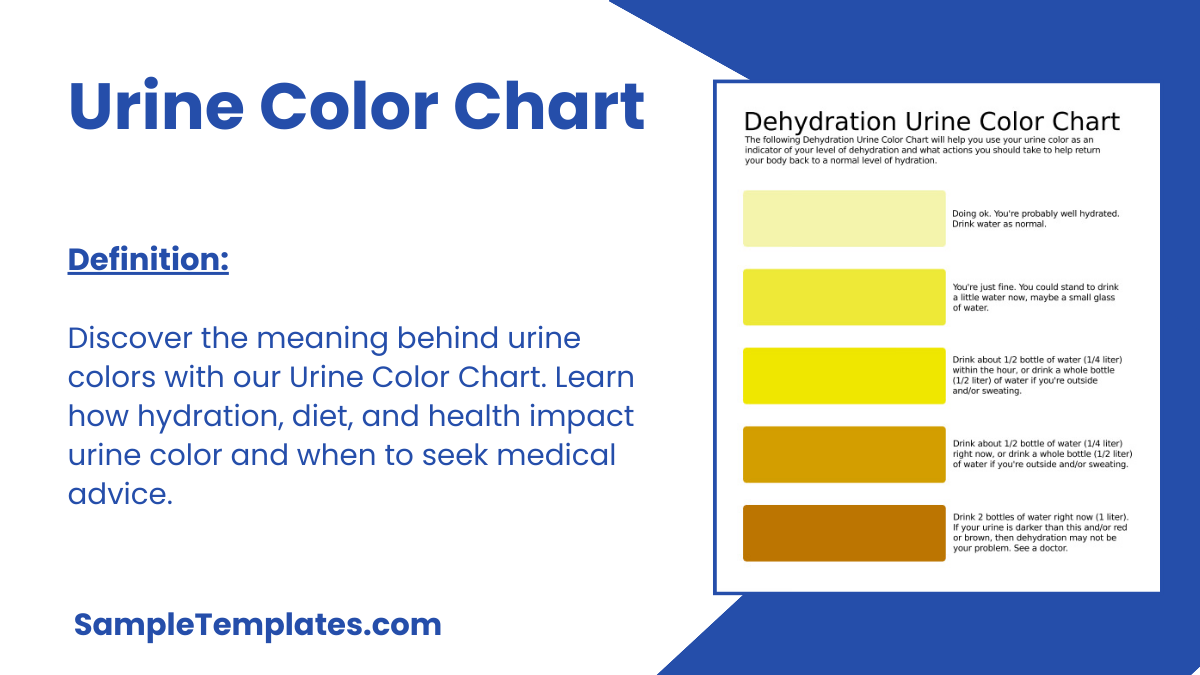The adage that colour of urine says a lot about your health is totally true. Stuff that you intake has a lot of effect on urine colour. Urine Colour Chart can easily tell whether you are hydrated enough or whether you have any medical condition that needs assistance.
These are must haves for doctors, hospitals, diagnostic lab and even a normal person. Download free samples of urine chart here in word or excel formats. Easily printed to be used at home or medical clinics. Available in variety of sizes as per your needs
Urine Color Chart Dehydration
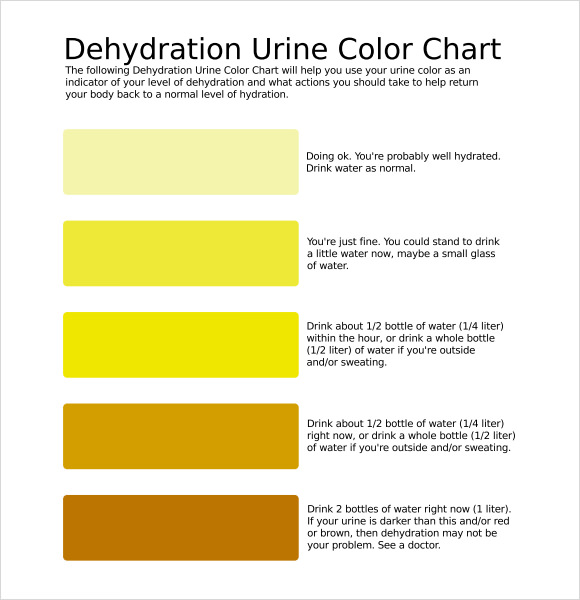
Why Urine Changes Color?
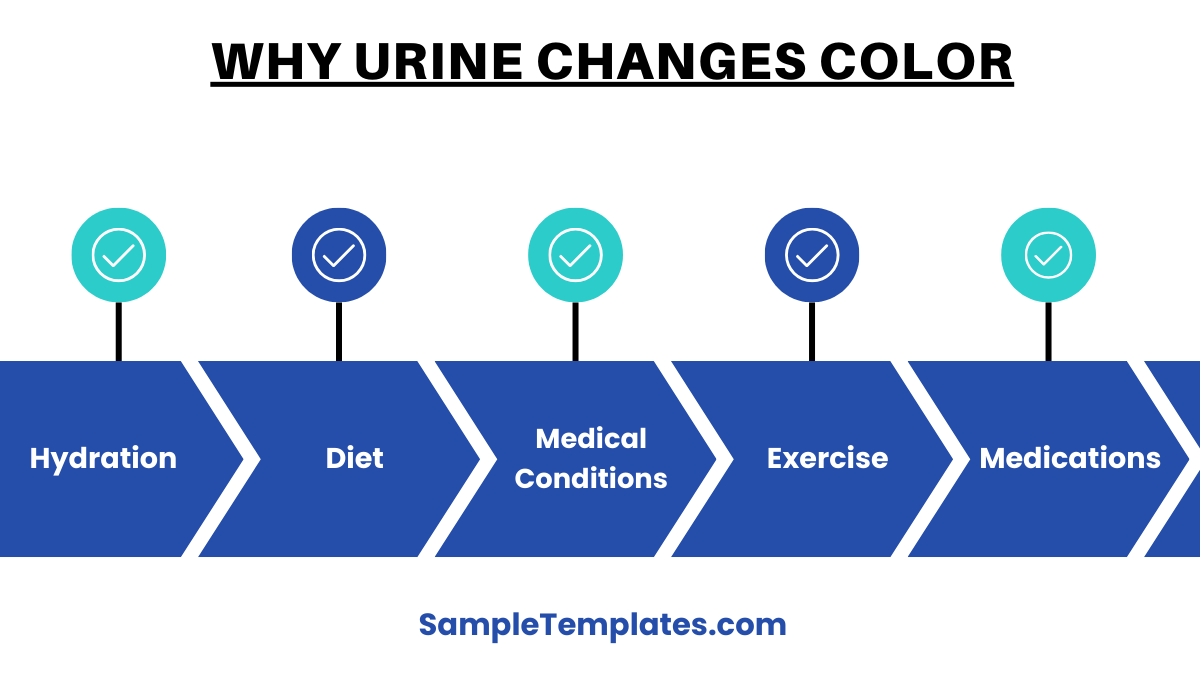
Urine color changes due to various factors, including:
- Hydration levels: Dark yellow or amber urine often indicates dehydration, while light yellow or clear urine typically signifies proper hydration.
- Diet: Certain foods, like beets, carrots, and berries, can change urine color.
- Medications and supplements: Some medications and vitamins can cause urine to turn colors such as bright yellow, orange, or even green.
- Medical conditions: Blood in the urine (hematuria) can cause a pink or red color, while liver disease might turn urine dark brown or tea-colored. Infections or conditions affecting the kidneys or bladder can also impact urine color.
- Exercise: Intense exercise can lead to dehydration or the presence of muscle breakdown products, affecting urine color.
Monitoring urine color can help indicate hydration status and potential health issues.
Printable Urine Color Chart
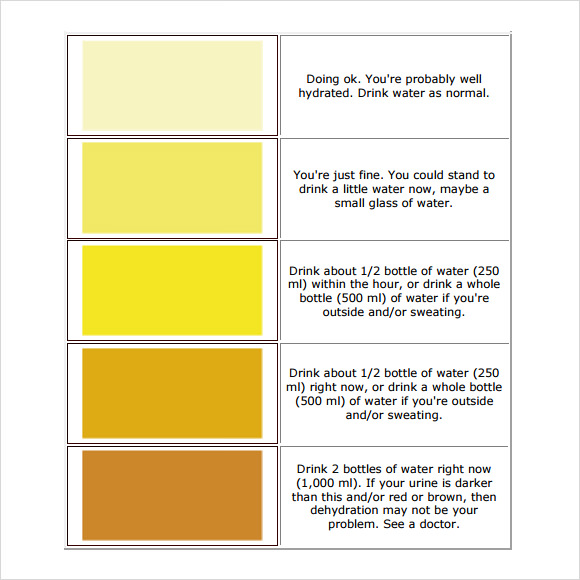
Normal Urine Color Chart Template
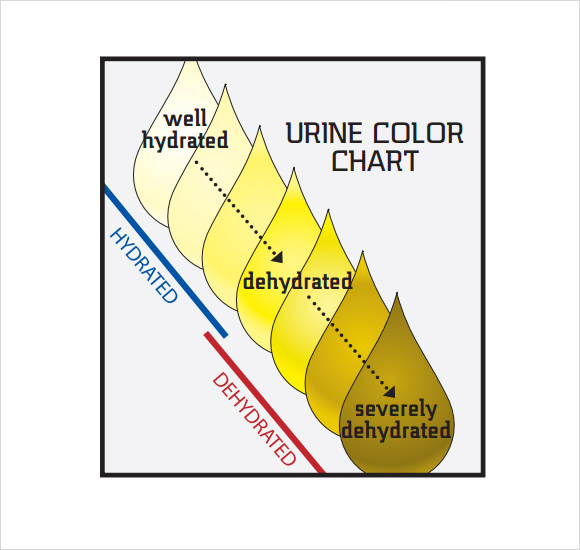
What are Bad Signs in Urine?
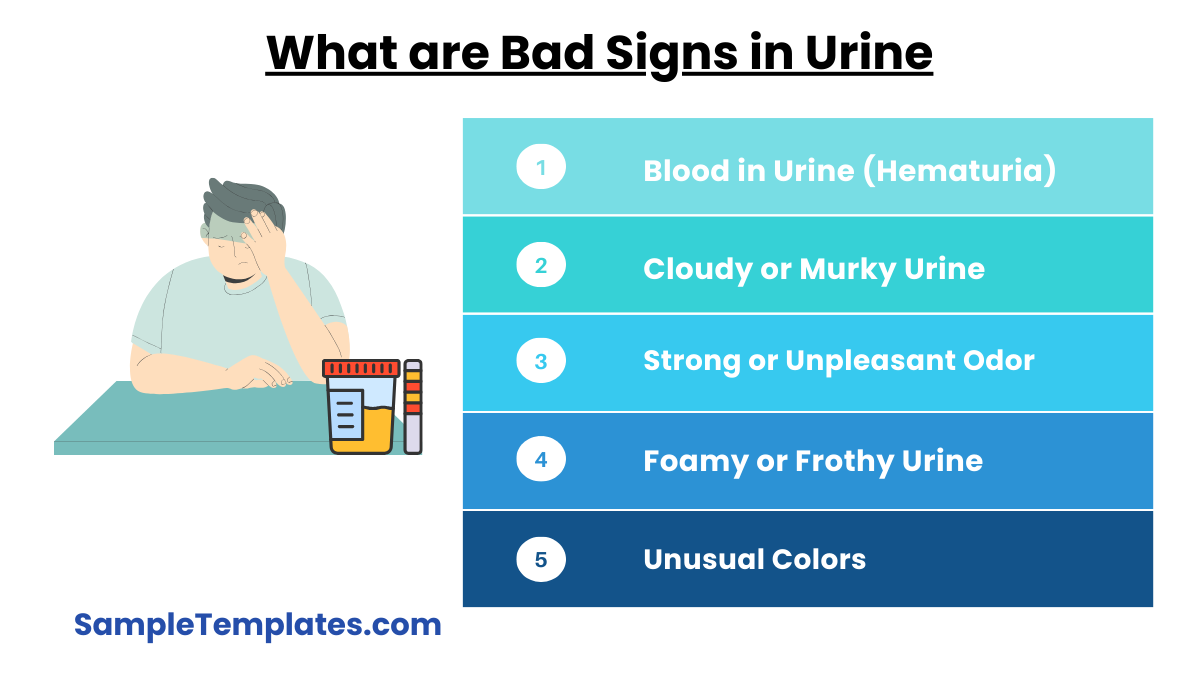
Certain changes in urine can indicate potential health issues. Here are some bad signs to watch for:
- Blood in Urine (Hematuria): Pink, red, or cola-colored urine may indicate the presence of blood, which can be a sign of infections, kidney stones, or more serious conditions like cancer.
- Dark Brown or Tea-Colored Urine: This could suggest liver or bile duct problems, especially if accompanied by yellow skin (jaundice).
- Cloudy or Murky Urine: May indicate a urinary tract infection (UTI) or the presence of certain minerals and proteins.
- Strong or Unpleasant Odor: While some odor is normal, a strong, foul smell can be a sign of infection, dehydration, or certain medical conditions.
- Foamy or Frothy Urine: Persistent foaminess can indicate excess protein in the urine, which might be a sign of kidney issues.
- Unusual Colors:
- Orange: Can be caused by dehydration, liver or bile duct issues, or certain medications.
- Blue or Green: Rare but can result from certain medications, dyes, or medical conditions.
If you sample notice any of these signs, it’s important to consult a healthcare professional for proper diagnosis and treatment.
Urine Color Chart Infection

Urine Color Chart for Hydration

What color urine should I be worried about?
You should be concerned about the following urine colors, as they can indicate underlying health issues:
- Red or Pink: This may suggest the presence of blood (hematuria), which can be a sign of urinary tract infections (UTIs), kidney stones, tumors, or other serious conditions.
- Dark Brown or Tea-Colored: Often associated with liver or bile duct problems, especially if accompanied by yellowing of the skin and eyes (jaundice).
- Cloudy or Milky: Can indicate a urinary tract infection, kidney stones, or the presence of certain minerals and proteins.
- Orange: Could be due to dehydration, liver or bile duct issues, or certain medications and dyes.
- Blue or Green: Rare but can result from certain medications, dyes used in medical tests, or specific bacterial infections.
If you observe any of these unusual colors in your urine, it is important to seek medical advice to determine the cause and appropriate treatment. You can also see more on General Color Chart.
Urine Color Chart Mayo Clinic
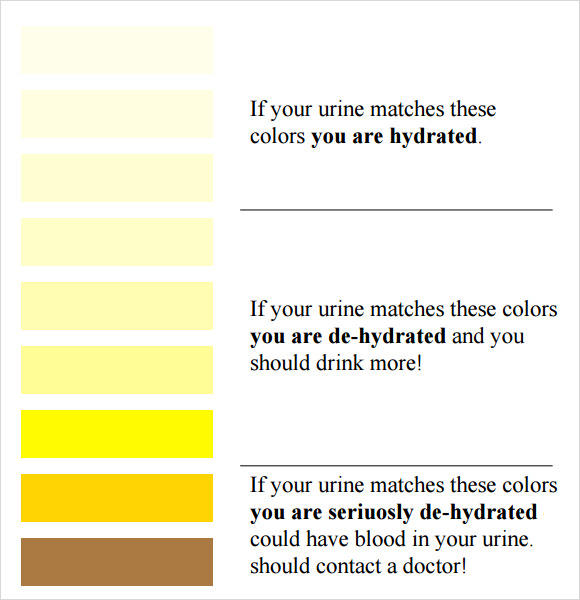
Urine Color Chart for Drug Test

How do you know if you have an infection in your urine?
Urinary tract infections (UTIs) can present several signs and symptoms. Here are common indicators that you might have an infection in your urine:
- Frequent Urination: An increased urge to urinate, often with little urine output.
- Burning Sensation: Pain or a burning feeling during urination.
- Cloudy Urine: Urine that appears cloudy or murky.
- Strong Odor: A strong, unpleasant smell in your urine.
- Blood in Urine: Pink, red, or cola-colored urine, indicating the presence of blood.
- Pelvic Pain: Pain or pressure in the lower abdomen or pelvic area, particularly in women.
- Back Pain: Pain in the lower back or flanks, which might suggest a kidney infection.
- Fever: Fever, chills, or flu-like symptoms can occur if the infection has reached the kidneys.
- General Malaise: Feeling unwell, tired, or fatigued.
If you experience any of these symptoms, it’s important to seek medical attention. A healthcare provider can diagnose a UTI through a urine test and recommend appropriate treatment, often involving antibiotics.
Sample Urine Color Chart Template
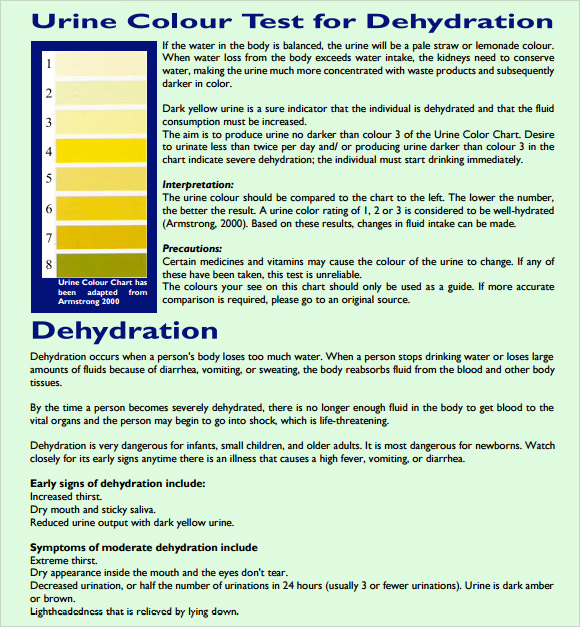
General Urine Color Chart
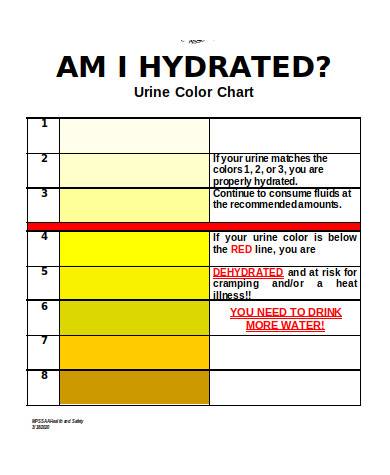
What color is diabetic pee?
Diabetic urine may appear clear or pale if glucose levels are high, leading to frequent urination. However, urine color alone is not a definitive indicator of diabetes. You can also see more on Medicine Chart.
What color is urine when your kidneys are failing?
When kidneys are failing, urine can be dark brown, tea-colored, or even reddish due to blood. Cloudiness may also indicate the presence of excess proteins or other substances.
What color is dehydrated urine?
Dehydrated urine is typically dark yellow or amber. This color indicates concentrated urine due to insufficient water intake and high waste concentration. You can also see more on Medication Chart.
What color is sugar in urine?
Sugar in urine doesn’t change its color but can lead to clear or pale urine due to frequent urination caused by high glucose levels, common in diabetes.
What color is urine with low electrolytes?
Urine with low electrolytes may appear clear or very light yellow due to dilution. This is usually a sign of overhydration or electrolyte imbalance. You can also see more on Pms Color Chart.
Which urine color is abnormal?
Abnormal urine colors include red, pink, dark brown, tea-colored, blue, green, and cloudy. These can indicate infections, blood presence, liver issues, or other medical conditions.
A urine color chart is a useful tool for monitoring hydration and overall health. By comparing urine color to the chart, individuals can quickly assess their hydration status and potentially detect health issues early.
If you have any DMCA issues on this post, please contact us!
Related Posts
Weekly Schedule Samples & Templates
Contractual Agreement Samples & Templates
FREE 9+ Amazing Sample Church Bulletin Templates in PSD | PDF
Sample Business Card Templates
Sample Cashier Job Descriptions
Questionnaire Samples
FREE 10+ Sample HR Resource Templates in PDF
FREE 10+ HR Consulting Business Plan Samples in MS Word | Google Docs | Pages | PDF
FREE 49+ Sample Job Descriptions in PDF | MS Word
FREE 16+ Nonprofit Budget Samples in PDF | MS Word | Excel | Google Docs | Google Sheets | Numbers | Pages
FREE 13+ Academic Calendar Templates in Google Docs | MS Word | Pages | PDF
FREE 10+ How to Create an Executive Summary Samples in Google Docs | MS Word | Pages | PDF
FREE 23+ Sample Event Calendar Templates in PDF | MS Word | Google Docs | Apple Pages
Company Profile Samples
FREE 10+ Leadership Report Samples [ Development, Training, Camp ]
